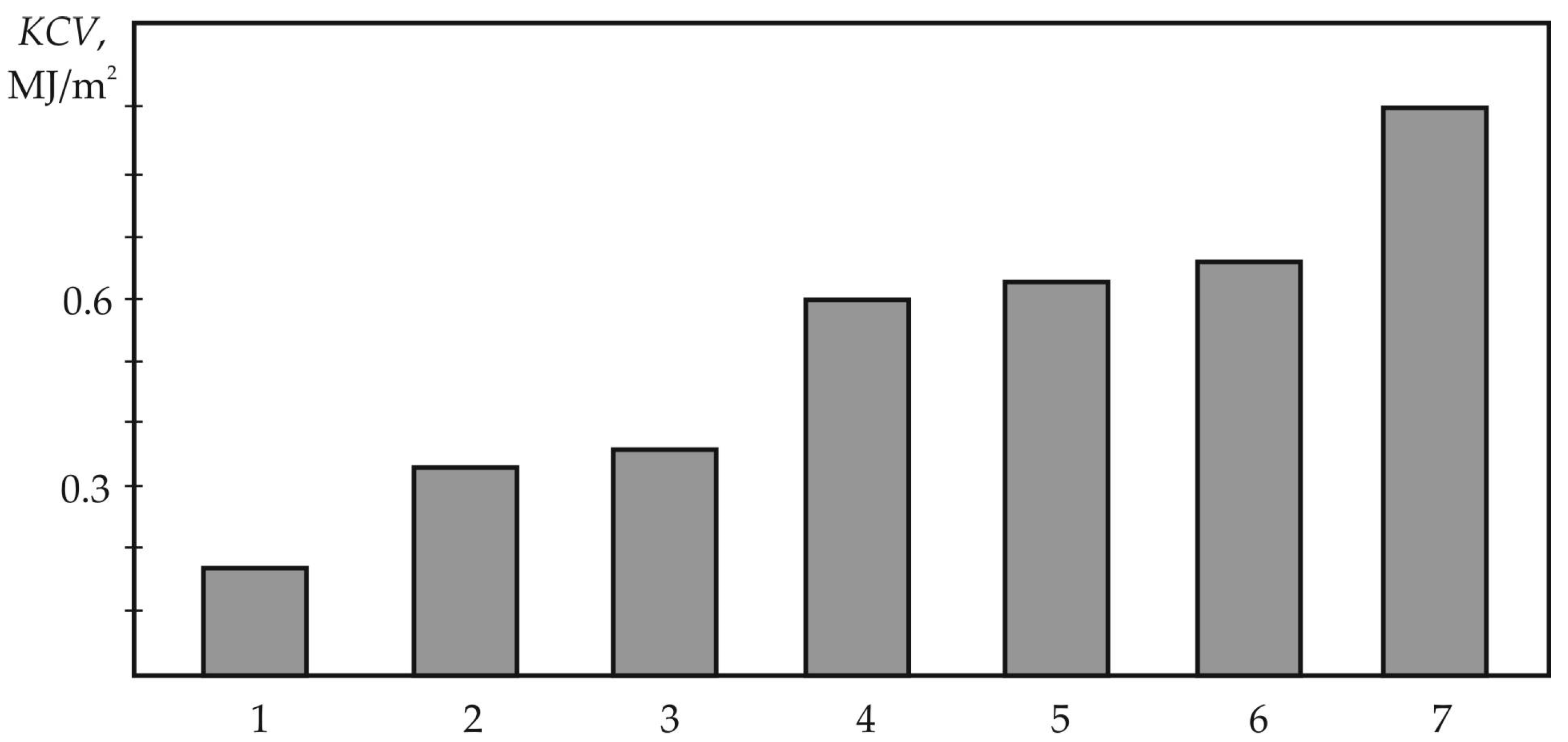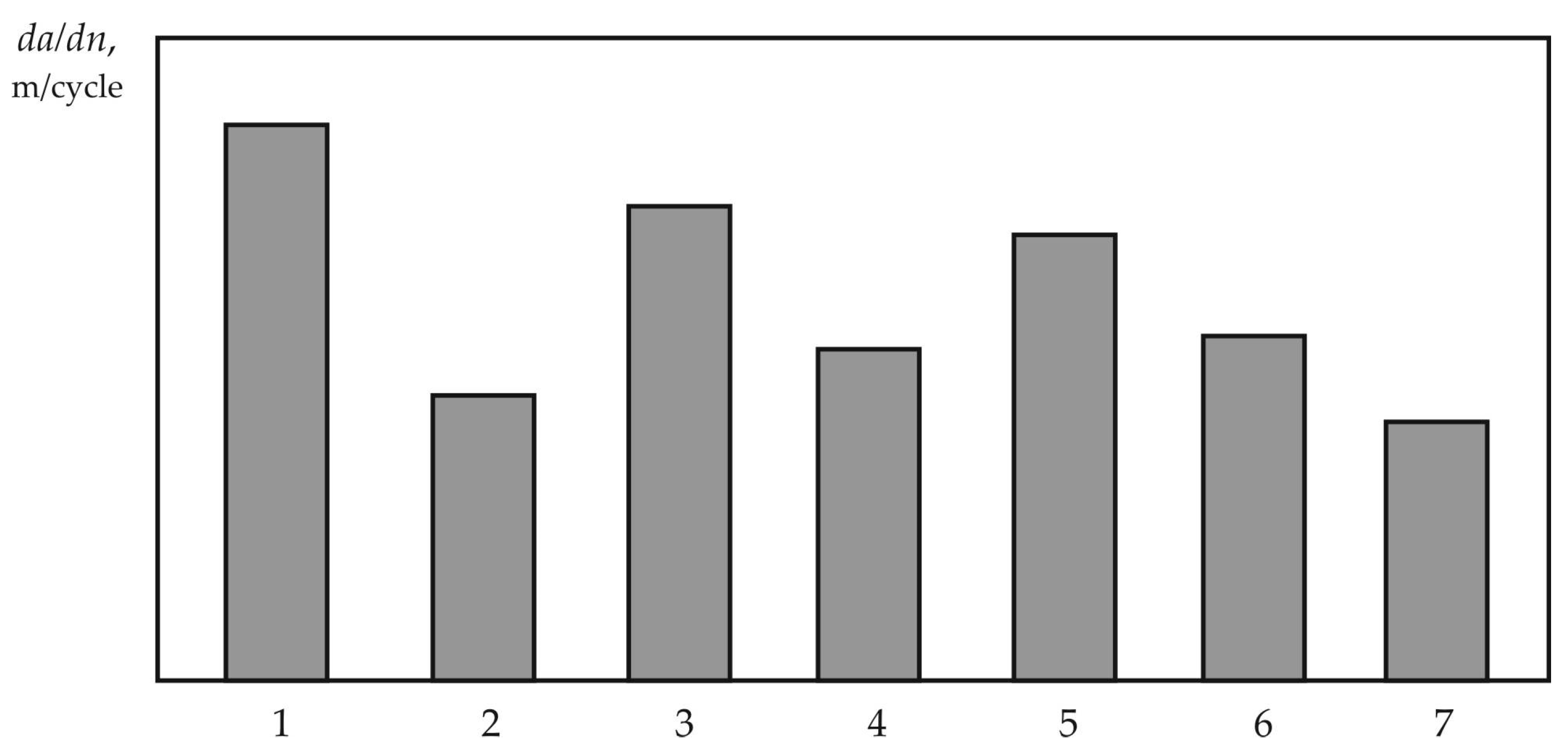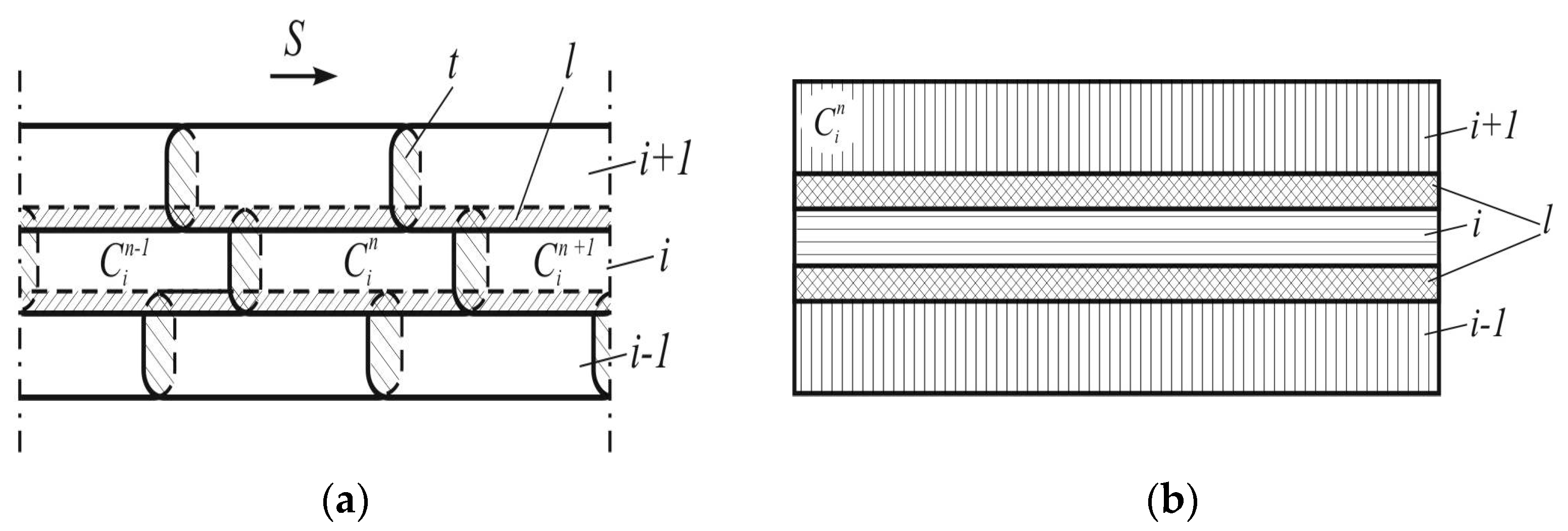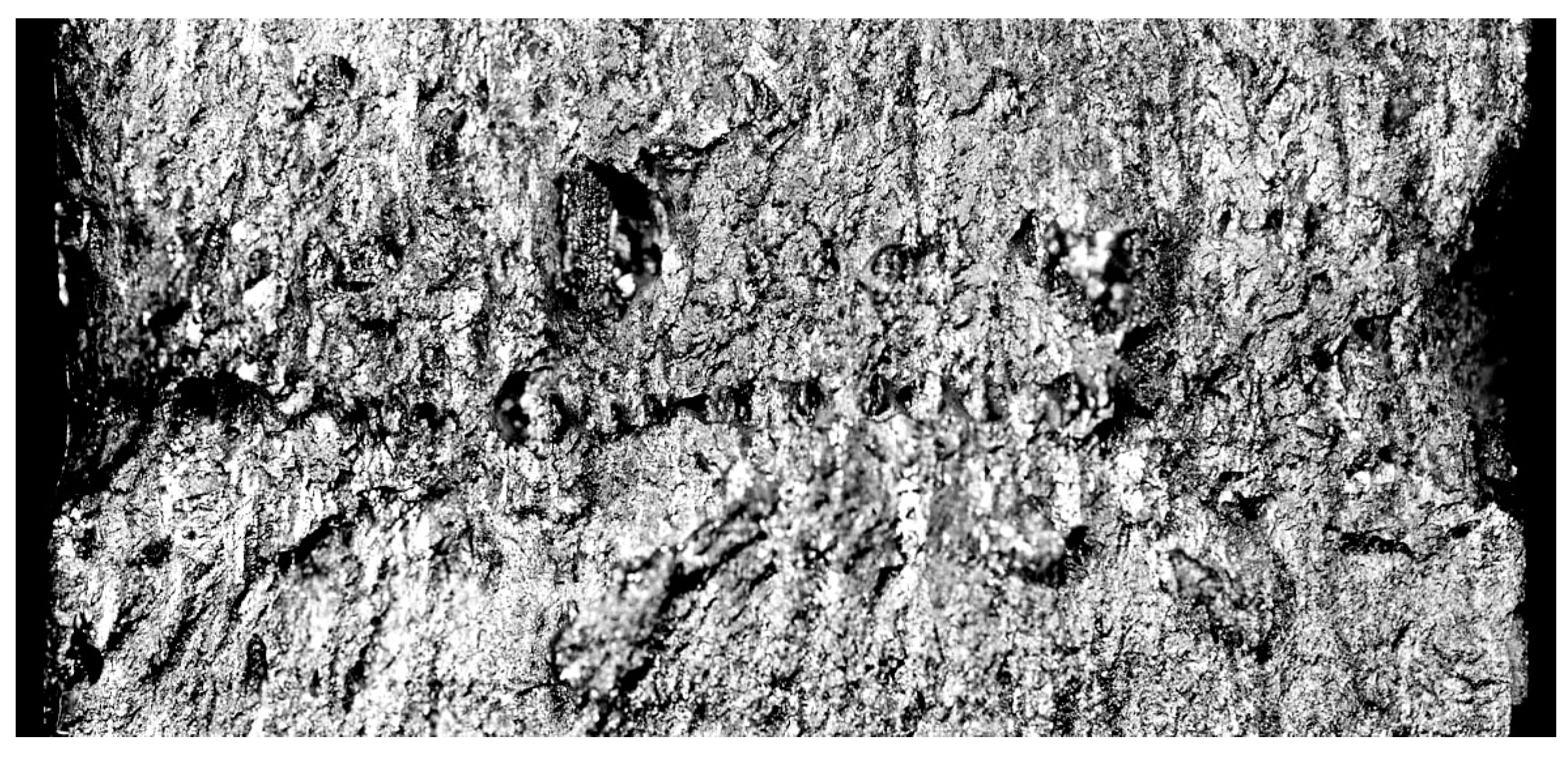Resistance of Heterogeneous Metal Compositions to Fracture under Dynamic and Cyclic Loads
Abstract
1. Introduction
2. Materials and Methods
2.1. Characteristics of the Studied Materials
2.2. Study of Macrostructural Characteristics of Monolithic Materials and Composites
3. Results and Discussion
4. Summary
- The improved resistance to dynamic load destruction of the studied heterogeneous multilayer composites obtained by fusion and pressure welding is related to crack retardation due to the lamination mechanism at the boundary between the strong and viscous layers. The integral value of the impact strength of these composites primarily depends on crack nucleation work.
- According to the analyzed data, residual stresses may increase the resistance to fatigue crack nucleation or crack retardation at the boundary of layers in heterogeneous composites.
- The dependency between dl/dN and ΔK appears linear when observing the kinetic diagram of fatigue failure mechanisms of monolithic materials with a cast or plastically deformed structure, as well as homogeneous layered deposited composites. However, in the case of multilayer composites consisting of viscous and strong layers that are connected by welding explosion, a sharp slowdown of fatigue crack occurs in the form of a dip due to the crack’s crossing the boundary between a strong and viscous layer.
Author Contributions
Funding
Data Availability Statement
Acknowledgments
Conflicts of Interest
References
- Ivanov, V.P.; Leshchinskiy, L.K.; Stepnov, K.K. Control of alloying process of weld metal of variable chemical composition. Weld. Int. 2021, 35, 441–446. [Google Scholar] [CrossRef]
- Moreira, F.; Ferreira, P.M.; Silva, R.J.C.; Santos, T.G.; Vidal, C. Aluminum-Based Dissimilar Alloys Surface Composites Reinforced with Functional Microparticles Produced by Upward Friction Stir Processing. Coatings 2023, 13, 962. [Google Scholar] [CrossRef]
- Kulasa, J.; Juszczyk, B.; Kováčik, J.; Emmer, Š.; Malara, S.; Malec, W.; Lis, M. Wear resistant and electrically conductive composite coatings on non-ferrous metals. In Proceedings of the European Congress and Exhibition on Advanced Materials and Processes, Thessaloniki, Greece, 17–22 September 2017. [Google Scholar]
- Berton, T.; Haldar, S.; Montesano, J.; Singh, C.V. Time-dependent damage analysis for viscoelastic-viscoplastic structural laminates under biaxial loading. Composite Struct. 2018, 203, 60–70. [Google Scholar] [CrossRef]
- Singh, C.V.; Talreja, R. Evolution of ply cracks in multidirectional composite laminates. Int. J. Solids Struct. 2010, 47, 1338–1349. [Google Scholar] [CrossRef]
- Lisiecki, A.; Kurc-Lisiecka, A. Laser Cladding of NiCrBSi/WC + W2C Composite Coatings. Coatings 2023, 13, 576. [Google Scholar] [CrossRef]
- Bondar, V.S.; Danshin, V.V.; Makarov, D.A. Mathematical modelling of deformation and damage accumulation under cyclic loading. PNRPU Mech. Bull. 2014, 2, 126–152. [Google Scholar] [CrossRef]
- Zhu, P.-N.; Gao, J.-X.; Yuan, Y.-P.; Wu, Z.-F.; Xu, R.-X. An Improved Multiaxial Low-Cycle Fatigue Life Prediction Model Based on Equivalent Strain Approach. Metals 2023, 13, 629. [Google Scholar] [CrossRef]
- Arutyunyan, A.R. Formulation of the fatigue strength criterion of composite materials. Bull. St. Petersburg Univ. Math. Mech. Astron. 2020, 7, 511–517. [Google Scholar] [CrossRef]
- Montesano, J.; McCleave, B.; Singh, C.V. Prediction of ply crack evolution and stiffness degradation in multidirectional symmetric laminates under multiaxial stress states. Compos. Part B-Eng. 2018, 133, 53–67. [Google Scholar] [CrossRef]
- Montesano, J.; Singh, C.V. Predicting evolution of ply cracks in composite laminates subjected to biaxial loading. Predicting evolution of ply cracks in composite laminates subjected to biaxial loading. Compos. Part B-Eng. 2015, 75, 264–273. [Google Scholar] [CrossRef]
- Gordon, J.E. The New Science of Strong Materials: Why Don’t We Fall through the Floor; Prinston University Press: Princeton, NJ, USA, 2018; 328p. [Google Scholar]
- Leshchinskii, L.K.; Matvienko, V.N.; Ivanov, V.P.; Vozyanov, E.I.; Karaulanov, O.V. Features of the deposition technology for the rollers resource increasing of the machines for continuous blanks casting. Weld. Int. 2019, 33, 298–301. Available online: https://www.tandfonline.com/doi/full/10.1080/09507116.2021.1874146 (accessed on 16 February 2021). [CrossRef]
- Mastenko, V.Y.; Volobuev, Y.S.; Volosov, N.A.; Mitrofanov, V.M.; Simonova, O.N.; Komolo, V.N. Electroslag deposition with tape under ceramic flux of a homogenious single-layer anticorrosion coating of the inner surface of pipes with a diameter of 850 and 900 mm for nuclear power plant. Weld. Int. 2019, 33, 308–314. [Google Scholar] [CrossRef]
- Strathy, D.; Brower, J.K. Roll and Overlay Technologies to Improve Operational Performance. Iron Steel Technol. 2007, 12, 49–60. [Google Scholar]
- Stepanova, T.R.; Prohorova, T.V. Creep and Rupture under the Complex Stress State. Mater. Sci. Forum 2016, 870, 528–534. [Google Scholar] [CrossRef]
- Gladkovsky, S.V.; Grunina, T.A.; Kokovkin, E.A.; Kuteneva, S.V. Investigation of the influence of structural elements and manufacturing method on the formation of the structure and properties of layered metal composites. Roll. Prod. Manuf. 2014, 6, 28–36. [Google Scholar]
- Lavrova, E.; Ivanov, V. Controlling the depth of penetration in the case of surfacing with a strip electrode at an angle to the generatrix. Mater. Sci. Forum 2018, 938, 27–32. [Google Scholar] [CrossRef]
- Maksimov, A.B. Propagation of cracks in the pipes of the inhomogeneous material. Izvestiya. Ferr. Metall. 2013, 56, 53–56. (In Russian) [Google Scholar] [CrossRef][Green Version]
- Smirnova, A.; Pochivalov, Y.; Panin, V.; Panin, S.; Eremin, A.; Gorbunov, A. The effect of advanced ultrasonic forging on fatigue fracture mechanism of welded Ti-6Al-4V alloy. Proceedings of the International Conference on Advance Materials with Hierarchical Structure for New Technologies and Reliable Structures. AIP Conf. Proc. 2017, 1909, 020206. [Google Scholar]
- Bhaumik, S.; Mukherjee, M.; Sarkar, P.; Nayek, A.; Paleu, V. Microstructural and Wear Properties of Annealed Medium Carbon Steel Plate (EN8) Cladded with Martensitic Stainless Steel (AISI410). Metals 2020, 10, 958. [Google Scholar] [CrossRef]
- Bogdanovich, A.V. Assessment of the main circulation pipeline resource of the NPP based on its crack resistance criterion while considering the operational degradation of properties. Bull. Natl. Acad. Sci. Belarus Ser. Phys. Tech. Sci. 2020, 65, 153–161. [Google Scholar]
- Gladkovsky, S.V.; Kuteneva, S.V.; Kamantsev, I.S.; Galeev, R.M.; Dvoynikov, D.V. Formation of the Properties and Fracture Resistance Characteristics of Sandwich Composites Based on the 09G2S Steel and the EP678 High-Strength Steel of Various Dispersion (Electronic resource). Diagn. Resour. Mech. Mater. Struct. 2017, 6, 71–90. [Google Scholar]
- Gopkalo, A.P.; Tsybanev, G.V.; Klipachevsky, V.V. Thermal stresses in rollers of continuous casting with varying properties of base metals and cladding. Met. Cast. Ukr. 2011, 7, 24–28. [Google Scholar]
- Samotugin, S.S.; Leshchinsky, L.K.; Mazur, V.A.; Samotugina, Y.S. Instrumental Materials: Properties and Hardening; PSTU: Mariupol, Ukraine, 2013; 430p. [Google Scholar]
- Botvina, L.R. Fracture. In Kinetics, General Mechanisms; Nauka Publisher: Moscow, Russia, 2008; 334p. [Google Scholar]




| N | Steel Grade | Content of Elements, Mass. % | ||||||||
|---|---|---|---|---|---|---|---|---|---|---|
| C | Mn | Si | Cr | Mo | V | S | P | + | ||
| 1 | 25Cr1Mo1V | 0.32 | 0.44 | 0.44 | 1.57 | 0.54 | 0.27 | 0.010 | 0.015 | 0.30 Ni |
| 2 | 17Cr12Mo2V | 0.17 | 0.52 | 0.24 | 11.2 | 2.08 | 0.21 | 0.019 | 0.020 | - |
| 3 | 35W9Cr3VSi | 0.32 | 0.80 | 0.60 | 2.50 | - | 0.30 | 0.025 | 0.030 | 8.80 W |
| 4 | 25Cr5VMoSi | 0.25 | 0.70 | 0.80 | 5.2 | 1.20 | 0.50 | 0.020 | 0.030 | - |
| 5 | 10Cr13 | 0.10 | 0.60 | 0.65 | 12.2 | - | - | 0.019 | 0.030 | - |
| 6 | 12Cr12Mn12SiV | 0.11 | 11.85 | 0.50 | 12.65 | - | 0.30 | 0.022 | 0.028 | 0.003 N |
| N | Steel Grade | Mechanical Properties | |||||
|---|---|---|---|---|---|---|---|
| KCV, MJ/m2 | σm, MPa | σ0.2, MPa | ψ, % | δ5, % | HV | ||
| 1 | 25Cr1Mo1V | 0.65 | 910 | 800 | 55 | 16 | 265 |
| 2 | 17Cr12Mo2V | 0.30 | 770 | 615 | 54 | 15 | 240 |
| 3 | 35W9Cr3VSi | 0.12 | 900 | 810 | 28 | 10 | 550 |
| 4 | 25Cr5VMoSi | 0.33 | 850 | 780 | 48 | 12 | 410 |
| 5 | 10Cr13 | 0.60 | 600 | 440 | 53 | 14 | 280 |
| 6 | 12Cr12Mn12SiV | 0.65 | 510 | 430 | 33 | 28 | 240 |
| N | Parameter | Material | |||
|---|---|---|---|---|---|
| 18Cr6MnMoVSi | 18Cr6MnMoVSi–15MnSi–18Cr6MnMoVSi | ||||
| 1 | Hardness, HV | 400 | 400 | 210 | 400 |
| 2 | KCV, MJ/m2 | 0.42 | 1.50 | ||
| 3 | Kcd, MPa∙m1/2 * | 46.0 | 65.0 | ||
| N | Composition of Composite’s Layers | KC, MJ/m2 | KCn, MJ/m2 | KCp, MJ/m2 | Kcd, MJ/m2 |
|---|---|---|---|---|---|
| 1 | 90CrV (4) 1 + 30CrMnSi (6) | 0.28 | 0.26 | 0.02 | 31.1 |
| 2 | 90CrV (4) + 15kp (3) + 30CrMnSi (3) | 0.36 | 0.28 | 0.08 | 55.2 |
| 3 | 90CrV (4) + 12Cr18Ni10Ti (3) + 30CrMnSi (3) | 0.48 | 0.25 | 0.23 | 58.7 |
| 4 | 90CrV (5) + 12Cr18Ni10Ti (3) + 30CrMnSi (2) | 0.42 | 0.31 | 0.11 | – |
| Roller Material | Cladding Material | Stresses, MPa | ||
|---|---|---|---|---|
| Type 1 | Roller Surface | Boundary with the Base Metal | ||
| 25Cr1Mo1V | 12Cr12Mn12SiV | σr | +300 | −200 |
| σr + σt | +850 | +300 | ||
| 25Cr1Mo1V | 10Cr13 | σr | −200 | +200 |
| σr + σt | +300 | +700 | ||
| 12Cr1Mo1V | 0Cr17Ni4 | σr | −269 | −139 |
| σr + σt | −119 | −2 | ||
Disclaimer/Publisher’s Note: The statements, opinions and data contained in all publications are solely those of the individual author(s) and contributor(s) and not of MDPI and/or the editor(s). MDPI and/or the editor(s) disclaim responsibility for any injury to people or property resulting from any ideas, methods, instructions or products referred to in the content. |
© 2023 by the authors. Licensee MDPI, Basel, Switzerland. This article is an open access article distributed under the terms and conditions of the Creative Commons Attribution (CC BY) license (https://creativecommons.org/licenses/by/4.0/).
Share and Cite
Leshchinskiy, L.K.; Ivanov, V.P.; Lavrova, E.V.; Il’yaschenko, D.P. Resistance of Heterogeneous Metal Compositions to Fracture under Dynamic and Cyclic Loads. Metals 2023, 13, 1899. https://doi.org/10.3390/met13111899
Leshchinskiy LK, Ivanov VP, Lavrova EV, Il’yaschenko DP. Resistance of Heterogeneous Metal Compositions to Fracture under Dynamic and Cyclic Loads. Metals. 2023; 13(11):1899. https://doi.org/10.3390/met13111899
Chicago/Turabian StyleLeshchinskiy, Leonid K., Vitaliy P. Ivanov, Elena V. Lavrova, and Dmitry P. Il’yaschenko. 2023. "Resistance of Heterogeneous Metal Compositions to Fracture under Dynamic and Cyclic Loads" Metals 13, no. 11: 1899. https://doi.org/10.3390/met13111899
APA StyleLeshchinskiy, L. K., Ivanov, V. P., Lavrova, E. V., & Il’yaschenko, D. P. (2023). Resistance of Heterogeneous Metal Compositions to Fracture under Dynamic and Cyclic Loads. Metals, 13(11), 1899. https://doi.org/10.3390/met13111899





